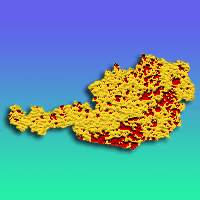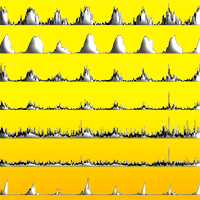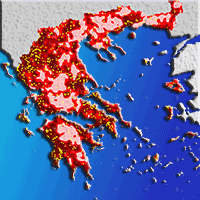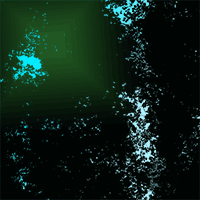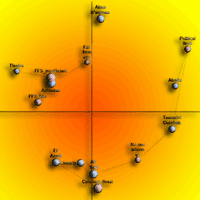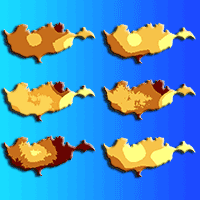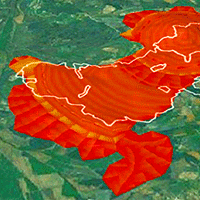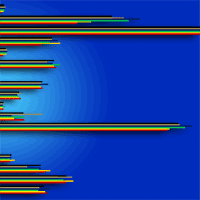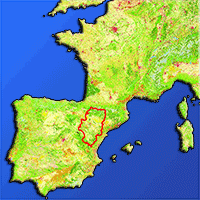Climate anomalies and potential increased human pressure will likely cause the increase in frequency and damage of forest fires in the near future. Therefore, accurately and temporally estimating and mapping forest fire probability is necessary for preventing from destructive effects of forest fires. In this study, the forest fire occurrence in Southwestern Turkey was modeled and mapped with the maximum entropy (MaxEnt) approach. We used past fire locations (from 2008 to 2018) with environmental variables such as fuel type, topography, meteorological parameters, and human activity for modeling and mapping, using data that could be obtained quickly and easily. The performances of fire occurrence models was quite satisfactory (AUC: range from 0.71 to 0.87) in terms of the model reliability. When the fire occurrence models were analyzed in detail, it was seen that the environmental variables with the highest gain when used alone were the maximum temperature, tree species composition, and distance to agricultural lands. To evaluate the models, we compared the fire locations between 2019 and 2020 with those on reclassified fire probability maps. Fire location from 2019-2020 fit substantially within the model fire occurrence predictions since many fire points in high or extreme fire probability categories has been observed. The results of this study can be a guideline for the Mediterranean forestry that has consistently struggled the forest fires and attempted to manage effectively forest lands at fire risk.
Keywords
, , , ,
Citation
Göltas M, Ayberk H, Kücük O (2024). Forest fire occurrence modeling in Southwest Turkey using MaxEnt machine learning technique. iForest 17: 10-18. - doi: 10.3832/ifor4321-016
Academic Editor
Davide Ascoli
Paper history
Received: Feb 02, 2023
Accepted: Nov 06, 2023
First online: Feb 02, 2024
Publication Date: Feb 29, 2024
Publication Time: 2.93 months
© SISEF - The Italian Society of Silviculture and Forest Ecology 2024
Open Access
This article is distributed under the terms of the Creative Commons Attribution-Non Commercial 4.0 International (https://creativecommons.org/licenses/by-nc/4.0/), which permits unrestricted use, distribution, and reproduction in any medium, provided you give appropriate credit to the original author(s) and the source, provide a link to the Creative Commons license, and indicate if changes were made.

Breakdown by View Type
(Waiting for server response...)
Article Usage
Total Article Views: 19047
(from publication date up to now)
Breakdown by View Type
HTML Page Views: 12615
Abstract Page Views: 2892
PDF Downloads: 3252
Citation/Reference Downloads: 0
XML Downloads: 288
Web Metrics
Days since publication: 672
Overall contacts: 19047
Avg. contacts per week: 198.41
Article Citations
Article citations are based on data periodically collected from the Clarivate Web of Science web site
(last update: Mar 2025)
Total number of cites (since 2024): 3
Average cites per year: 1.50
Publication Metrics
by Dimensions ©
Articles citing this article
List of the papers citing this article based on CrossRef Cited-by.
(1)
Akyüz T (2019)Bursa Orman Bölge Müdürlügü’nde Yangin Tehlikesinin Modellenmesi ve Haritalanmasi [Fire hazard modeling and mapping in Bursa Forest Directorate]. Master Thesis, Kastamonu University, Graduate School of Natural and Applied Sciences, Kastamonu, Turkey, pp. 41. [in Turkish]
Gscholar
(2)
Aricak B, Kücük O, Enez K (2014)Determining a fire potential map based on stand age, stand closure and tree species, using satellite imagery (Kastamonu Central Forest Directorate Sample). Croatian Journal of Forest Engineering 35: 101-108.
Gscholar
(3)
Austin PC, Tu JV (2004)Bootstrap methods for developing predictive models. The American Statistician 58: 131-137.
CrossRef |
Gscholar
(4)
Baldwin RA (2009)Use of maximum entropy modeling in wildlife research. Entropy 11 (4): 854-866.
CrossRef |
Gscholar
(5)
Baysal I (2021)Vertical crown fuel distributions in natural Calabrian pine (
Pinus brutia Ten.) stands. Croatian Journal of Forest Engineering: Journal for Theory and Application of Forestry Engineering 42: 301-312.
CrossRef |
Gscholar
(6)
Bekar I, Tavsanoglu C, Pezzatti GB, Vacik H, Pausas JG, Bugmann H, Petter G (2020)Cross-regional modelling of fire occurrence in the Alps and the Mediterranean Basin. International Journal of Wildland Fire 29 (8): 712-722.
CrossRef |
Gscholar
(7)
Bilgili E, Coskuner KA, Usta Y, Goltas M (2019a)Modeling surface fuels moisture content in
Pinus brutia stands. Journal of Forestry Research 30: 577-587.
CrossRef |
Gscholar
(8)
Bilgili E, Coskuner KA, Usta Y, Saglam B, Kücük O, Berber T, Goltas M (2019b)Diurnal surface fuel moisture prediction model for Calabrian pine stands in Turkey. iForest - Biogeosciences and Forestry 12: 262-271.
CrossRef |
Gscholar
(9)
Bilgili E, Kücük O, Saglam B, Coskuner KA (2021)Büyük Orman Yanginlari: Sebepleri, Organizasyonu ve Idaresi [Mega forest fires: causes, organization and management]. In: “Orman Yanginlari” [“Forest Fires”]. Turkish Academy of Sciences, Ankara, Turkey, pp. 23. [in Turkish]
Gscholar
(10)
Brooke CT (2017)Identifying the environmental controls on wildland fire in the South-Central United States. Master Thesis, The Office of Graduate and Professional Studies of Texas A&M University, College Station, TX, USA, pp. 93.
Gscholar
(11)
Bustillo Sánchez M, Tonini M, Mapelli A, Fiorucci P (2021)Spatial assessment of wildfires susceptibility in Santa Cruz (Bolivia) using Random Forest. Geosciences 11 (5): 224.
CrossRef |
Gscholar
(12)
Chang Y, Zhu Z, Bu R, Chen H, Feng Y, Li Y, Hu Y, Wang Z (2013)Predicting fire occurrence patterns with logistic regression in Heilongjiang Province, China. Landscape Ecology 28: 1989-2004.
CrossRef |
Gscholar
(13)
Chen F, Du Y, Niu S, Zhao J (2015)Modeling forest lightning fire occurrence in the Daxinganling Mountains of Northeastern China with MAXENT. Forests 6: 1422-1438.
CrossRef |
Gscholar
(14)
Coskuner KA (2019)Turkish national forest fire danger rating decision support system (TOYTOS). Doctoral Thesis, Karadeniz Technical University, Graduate School of Natural and Applied Science, Trabzon, Turkey, pp. 126.
Gscholar
(15)
Devisscher T, Anderson LO, Aragão LE, Galván L, Malhi Y (2016)Increased wildfire risk driven by climate and development interactions in the Bolivian Chiquitania, Southern Amazonia. PLoS One 11 (9): e0161323.
CrossRef |
Gscholar
(16)
Dickey W (2018)Spatial analysis of human activities and wildfires in the Willamette National Forest. Master Thesis, University of Southern California, Faculty of the USC Graduate School, Los Angeles, CA, USA, pp. 91.
Online |
Gscholar
(17)
Donoghue LR, Main WA (1985)Some factors influencing wildfire occurrence and measurement of fire prevention effectiveness. Journal of Environmental Management 20: 87-96.
Gscholar
(18)
Elith J, Leathwick JR (2009)Species distribution models: ecological explanation and prediction across space and time. Annual Review of Ecology, Evolution and Systematics 40: 677-697.
CrossRef |
Gscholar
(19)
Elith J, Phillips SJ, Hastie T, Dudík M, Chee YE, Yates CJ (2011)A statistical explanation of MaxEnt for ecologists. Diversity and Distributions 17: 43-57.
CrossRef |
Gscholar
(20)
ESRI (2017)ArcMAP 10.5. Get started with ArcMap. Web site.
Online |
Gscholar
(21)
Evcin O, Kücük O, Akturk E (2019)Habitat suitability model with maximum entropy approach for European roe deer (
Capreolus capreolus) in the Black Sea Region. Environmental Monitoring and Assessment 191: 1-13.
CrossRef |
Gscholar
(22)
Flannigan MD, Logan KA, Amiro BD, Skinner WR, Stocks BJ (2005)Future area burned in Canada. Climatic Change 72 (1-2): 1-16.
CrossRef |
Gscholar
(23)
Fick SE, Hijmans RI (2017)WorldClim 2: new 1km spatial resolution climate surfaces for global land areas. International Journal of Climatology 37 (12): 4302-4315.
CrossRef |
Gscholar
(24)
Fuchs H, Magdon P, Kleinn C, Flessa H (2009)Estimating aboveground carbon in a catchment of the Siberian forest tundra: combining satellite imagery and field inventory. Remote Sensing of Environment 113: 518-531.
CrossRef |
Gscholar
(25)
Garcia CV, Woodard PM, Titus SJ, Adamowicz WL, Lee BS (1995)A logit model for predicting the daily occurrence of human caused forest-fires. International Journal of Wildland Fire 5: 101-111.
CrossRef |
Gscholar
(26)
GDF (2021)General Directorate of Forestry, Forestry Official Statistics in Turkey. Web site. [in Turkish]
Online |
Gscholar
(27)
GDF (2022)General Directorate of Forestry, Forestry Official Statistics in Turkey. Web site. [in Turkish]
Online |
Gscholar
(28)
Giglio L, Boschetti L, Roy DP, Humber ML, Justice CO (2018)The collection 6 MODIS burned area mapping algorithm and product. Remote Sensing of Environment 217: 72-85.
CrossRef |
Gscholar
(29)
Harris I, Osborn TJ, Jones PD, Lister DH (2020)Version 4 of the CRU TS monthly high-resolution gridded multivariate climate dataset. Scientific Data 7: 109.
CrossRef |
Gscholar
(30)
Jain P, Coogan SC, Subramanian SG, Crowley M, Taylor S, Flannigan MD (2020)A review of machine learning applications in wildfire science and management. Environmental Reviews 28 (4): 478-505.
CrossRef |
Gscholar
(31)
Kücük O, Bilgili E (2008)Crown fuel characteristics and fuel load estimates in young Calabrian pine (
Pinus brutia Ten.) stands in northwestern Turkey. Fresenius Environmental Bulletin 17: 2226-2231.
Online |
Gscholar
(32)
Kücük O, Goltas M, Demirel T, Mitsopoulos I, Bilgili E (2021)Predicting canopy fuel characteristics in
Pinus brutia Ten.,
Pinus nigra Arnold and
Pinus pinaster Ait. forests from stand variables in North-Western Turkey. Environmental Engineering and Management Journal 20 (2): 309-318.
CrossRef |
Gscholar
(33)
Li Y, Feng Z, Chen S, Zhao Z, Wang F (2020)Application of the artificial neural network and support vector machines in forest fire prediction in the Guangxi Autonomous Region, China. Discrete Dynamics in Nature and Society 2020: e5612650.
CrossRef |
Gscholar
(34)
Liang H, Zhang M, Wang H (2019)A neural network model for wildfire scale prediction using meteorological factors. IEEE Access 7: 176746-176755.
CrossRef |
Gscholar
(35)
Maier HR, Dandy GC, Burch MD (1998)Use of artificial neural networks for modelling cyanobacteria
Anabaena spp. in the River Murray, South Australia. Ecological Modelling 105: 257-272.
CrossRef |
Gscholar
(36)
Marier HR, Dandy GC (2000)Neural networks for the prediction and forecasting of water resource variables: a review of modeling issues and application. Environmental Modeling and Software 15: 101-124.
CrossRef |
Gscholar
(37)
Massada AB, Syphard AD, Stewart SI, Radeloff VC (2013)Wildfire ignition-distribution modelling: a comparative study in the Huron-Manistee National Forest, Michigan, USA. International Journal of Wildland Fire 22 (2): 174-183.
CrossRef |
Gscholar
(38)
McKenzie D, Gedalof ZE, Peterson DL, Mote P (2004)Climatic change, wildfire, and conservation. Conservation Biology 18 (4): 890-902.
CrossRef |
Gscholar
(39)
Moreno R, Zamora R, Molina JR, Vasquez A, Herrera MA (2011)Predictive modeling of microhabitats for endemic birds in South Chilean temperate forests using maximum entropy (MaxEnt). Ecological Informatics 6: 364-370.
CrossRef |
Gscholar
(40)
Musabašić M, Mušić D, Babović E (2021)Fire prediction with logistic regression on territory of Bosnia and Herzegovina. IOP Conference Series: Materials Science and Engineering 1208: 012033.
CrossRef |
Gscholar
(41)
Parisien MA, Moritz MA (2009)Environmental controls on the distribution of wildfire at multiple spatial scales. Ecological Monographs 79 (1): 127-154.
CrossRef |
Gscholar
(42)
Phillips SJ, Anderson RP, Schapire RE (2006)Maximum entropy modeling of species geographic distributions. Ecological Modelling 190: 231-259.
CrossRef |
Gscholar
(43)
Preisler HK, Brillinger DR, Burgan RE, Benoit JW (2004)Probability based models for estimation of wildfire risk. International Journal of Wildland Fire 13 (2): 133.
CrossRef |
Gscholar
(44)
Saglam B, Bilgili E, Dincdurmaz B, Kadiogulari AI, Kücük O (2008)Spatio-temporal analysis of forest fire risk and danger using LANDSAT imagery. Sensors 8: 3970-3987.
CrossRef |
Gscholar
(45)
Satir O, Berberoglu S, Donmez C (2016)Mapping regional forest fire probability using artificial neural network model in a Mediterranean forest ecosystem. Geomatics, Natural Hazards and Risk 7: 1645-1658.
CrossRef |
Gscholar
(46)
Sevinc V, Kücük O, Goltas M (2020)A Bayesian network model for prediction and analysis of possible forest fire causes. Forest Ecology and Management 457: 117723.
CrossRef |
Gscholar
(47)
Sivrikaya F, Kücük O (2022)Modeling forest fire risk based on GIS-based analytical hierarchy process and statistical analysis in Mediterranean region. Ecological Informatics 68 (3): 101537.
CrossRef |
Gscholar
(48)
Sun H, Wang Q, Wang G, Lin H, Luo P, Li J, Zeng S, Xu X, Ren L (2018)Optimizing kNN for mapping vegetation cover of arid and semi-arid areas using Landsat images. Remote Sensing 10: 1248.
CrossRef |
Gscholar
(49)
Tshering K, Thinley P, Shafapour Tehrany M, Thinley U, Shabani F (2020)A comparison of the qualitative analytic hierarchy process and the quantitative frequency ratio techniques in predicting forest fire-prone areas in Bhutan using GIS. Forecasting 2 (2): 36-58. doi:
CrossRef |
Gscholar
(50)
Wang M, Borders BE, Zhao D (2008)An empirical comparison of two subject-specific approaches to dominant heights modeling: the dummy variable method and the mixed model method. Forest Ecology and Management 255: 2659-2669.
CrossRef |
Gscholar
(51)
Yesilnacar EK (2005)The application of computational intelligence to landslide susceptibility mapping in Turkey. University of Melbourne, Australia, pp. 395.
Gscholar
(52)
Zhang B, Wang H (2022)Exploring the advantages of the maximum entropy model in calibrating cellular automata for urban growth simulation: a comparative study of four methods. GIScience and Remote Sensing 59: 71-95.
CrossRef |
Gscholar
(53)
Zuur AF, Ieno EN, Elphick CS (2010)A protocol for data exploration to avoid common statistical problems. Methods in Ecology and Evolution 1 (1): 3-14.
CrossRef |
Gscholar


